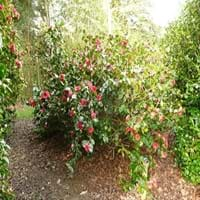Life Span
Perennial
Perennial
Type
Fruit
Broadleaf Evergreen
Origin
China
China, Japan, Korea
Types
Actinidia deliciosa chlorocarpa, Actinidia deliciosa deliciosa
Not Available
Habitat
Mountain forests
Dappled Shade, Shady Edge, Woodland Garden
USDA Hardiness Zone
6-9
7-9
Sunset Zone
4, 5, 6, 7, 8, 9, 12, 14, 15, 16, 17, 18, 19, 20, 21, 22, 23, 24
4, 5, 6, 7, 8, 9, 12, 14, 15, 16, 17, 18, 19, 20, 21, 22, 23, 24
Habit
Vining/Climbing
Oval/Rounded
Minimum Width
Not Available
Flower Color
Light Yellow, Ivory
Light Pink
Flower Color Modifier
Bicolor
Not Available
Fruit Color
Tan, Brown
Black
Leaf Color in Spring
Green, Light Green
Dark Green
Leaf Color in Summer
Green
Dark Green
Leaf Color in Fall
Light Green, Yellow green
Dark Green
Leaf Color in Winter
Light Green
Dark Green
Leaf Shape
Heart-shaped
Ovate
Plant Season
Spring, Summer, Fall
Spring, Summer, Fall, Winter
Sunlight
Full Sun, Partial Sun
Partial Sun, Partial shade
Type of Soil
Clay, Loam
Loam
The pH of Soil
Acidic, Neutral
Acidic, Neutral
Soil Drainage
Average
Average
Bloom Time
Late Spring, Early Summer
Early Spring, Late Winter
Tolerances
Drought
Not Available
Where to Plant?
Ground
Ground, Pot
How to Plant?
Layering, Softwood cuttings
Cuttings, Seedlings
Plant Maintenance
Medium
Medium
Watering Requirements
Water daily during growing season
Average Water Needs, Do Not over Water
In Summer
Lots of watering
Drought Tolerant, Average Water
In Spring
Moderate
Moderate
In Winter
Average Water
Average Water
Soil pH
Acidic, Neutral
Acidic, Neutral
Soil Type
Clay, Loam
Loam
Soil Drainage Capacity
Average
Average
Sun Exposure
Full Sun, Partial Sun
Partial Sun, Partial shade
Pruning
Prune for shortening long shoots, Prune in early summer, Prune in late winter
Remove damaged leaves, Remove dead branches, Remove dead leaves
Fertilizers
Self-fertile
10-10-10, 8-8-8
Pests and Diseases
Armillaria root rot, Armored scales, Bleeding canker, Botrytis Blight, Crown gall, Nematodes, Phytophthora Root Rot, Red blotch
Black Mold, Flower Blight, Free of serious pests and diseases, Leaf Gall, Leaf spot
Plant Tolerance
Drought
Not Available
Flower Petal Number
Single
Double
Foliage Texture
Medium
Medium
Foliage Sheen
Matte
Glossy
Attracts
Not Available
Butterflies
Allergy
Inflammation, Mouth itching, Throat itching
no allergic reactions
Aesthetic Uses
Not Used For Aesthetic Purpose
Bonsai
Beauty Benefits
Beautiful Skin, Protects from sun damage
Not Available
Environmental Uses
Air purification
Air purification
Medicinal Uses
constipation, Heart problems, Low Blood Pressure
Astringent, Cancer, Haemostatic, Salve, Tonic
Part of Plant Used
Fruits
Flowers, Leaves, Seeds
Other Uses
Used As Food, Used for its medicinal properties
As a tea substitute, Used as a hair-dressing oil, Used for making green dye
Used As Indoor Plant
No
Yes
Used As Outdoor Plant
Yes
Yes
Garden Design
Edible, Fruit / Fruit Tree, Rock Garden / Wall, Vine
Feature Plant, Foundation, Mixed Border, Topiary, Bonsai, Espalier
Botanical Name
ACTINIDIA deliciosa
CAMELLIA japonica 'Debutante'
Common Name
Chinese Gooseberry, Fuzzy Kiwi, Kiwi
Camellia, Debutante Camellia, Japanese Camellia
In Hindi
कीवी फल
Japanese Camellia
In German
Kiwi, Chinesischer Strahlengriffel
Japanische Kamelie
In French
Kiwi, Groseille de Chine, Yang Tao, Souris végétale
Camellia japonais
In Spanish
kiwi, kivi, actinidia
Camelia japonesa
In Greek
Ακτινίδια
Ιαπωνικά Camellia
In Portuguese
Quiuí
Camellia japonês
In Polish
Owoc kiwi
Japoński Camellia
In Latin
Kiwi fructum
Camellia Italica
Phylum
Magnoliophyta
Magnoliophyta
Class
Magnoliopsida
Magnoliopsida
Family
Actinidiaceae
Theaceae
Clade
Angiosperms, Asterids, Eudicots
Angiosperms, Asterids, Eudicots
Tribe
Not Available
Theaeae
Subfamily
Not Available
Theoideae
Number of Species
Not Available
Season and Care of Kiwifruit and Japanese Camellia
Season and care of Kiwifruit and Japanese Camellia is important to know. While considering everything about Kiwifruit and Japanese Camellia Care, growing season is an essential factor. Kiwifruit season is Spring, Summer and Fall and Japanese Camellia season is Spring, Summer and Fall. The type of soil for Kiwifruit is Clay, Loam and for Japanese Camellia is Loam while the PH of soil for Kiwifruit is Acidic, Neutral and for Japanese Camellia is Acidic, Neutral.
Kiwifruit and Japanese Camellia Physical Information
Kiwifruit and Japanese Camellia physical information is very important for comparison. Kiwifruit height is 610.00 cm and width Not Available whereas Japanese Camellia height is 210.00 cm and width 165.00 cm. The color specification of Kiwifruit and Japanese Camellia are as follows:
Kiwifruit flower color: Light Yellow and Ivory
Kiwifruit leaf color: Green and Light Green
Japanese Camellia flower color: Light Pink
- Japanese Camellia leaf color: Dark Green
Care of Kiwifruit and Japanese Camellia
Care of Kiwifruit and Japanese Camellia include pruning, fertilizers, watering etc. Kiwifruit pruning is done Prune for shortening long shoots, Prune in early summer and Prune in late winter and Japanese Camellia pruning is done Remove damaged leaves, Remove dead branches and Remove dead leaves. In summer Kiwifruit needs Lots of watering and in winter, it needs Average Water. Whereas, in summer Japanese Camellia needs Drought Tolerant, Average Water and in winter, it needs Average Water.





